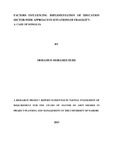| dc.description.abstract | This research project looked at factors that influence effectiveness of Education SWAp in situations of fragility, with specific reference to Republic of Somalia. After twenty years of conflict, Somalia has been classified as the world’s most fragile state with causes of conflict remaining deep and complex. However, the general statistics for the whole of Somalia are misleading to the extent that the country is effectively divided into three parts and its three separate administrations (Somaliland (SL), Puntland (PL) and Central South Zone (CSZ) represent different levels of fragility and stages of development. Donor support to education, much of it through NGOs, remains fragmented and inadequate. The Somalia situation requires different interpretations of the application of the sector-wide approach which underlies much development partner thinking. The need to understand how national level policies (including policy and planning environment), development partners practices (including their commitment to aid effectiveness principles) and institutional capacity (to plan, manage and monitor) education service delivery and support will influence the effectiveness of education SWAp will go a long way to understanding how best to maximise potential of SWAp adoption in other regions of Somalia and elsewhere, where similar situation of fragility exists. The study used a mixed method approach, which is a procedure for collecting, analysing and mixing both qualitative and quantitative data and targetd those stakeholders who can influence the design and outcome of SWAp most(development partners, Education officials and independent SWAp experts). Data collection methods included extensive desk-based literature review which collected secondary data and used questionnaires and semi-structured interviews to collect primary data and analysed using both qualitative and quantitative techniques. The key findings of the study were that SWAps have played a pivotal role in enabling dramatic increases in the provision of and enrolment in fee-free primary education in low-income countries; nevertheless the track record is less positive in relation to improving the quality of education. SWAps are relevant in FCAS and implementing well-designed SWAps contributes positively to state-building. The study found that National Level Policies and Institutional Capacity has the highest effect on Effectiveness of Education SWAp in situations of Fragility while Development Partners’ Practices has the least effect. 51.6%, the respondents felt that the National policy and Sector Implementation is usually as Envisioned while 26.3% of the respondents stated to some extent while those who stated that it was to a very little extent and no extent had 7.4% and 4.2% respectively. National level policy plays key roles in the effectiveness of SWAps therefore the researcher recommends that fragile states should have sound policy papers and enforce the adherences to them while implementing any projects. Further, the study recommended that a variety of financing modalities can be used o support a SWAp, donors should seek to be inclusive in their partnerships with one another rather than forming exclusive alliances to the detriment of long-term institutional development of the ministry of education. Partner governments and donors need to ensure that the design and implementation of a SWAp draws upon comprehensive political economy analysis and is sensitive to existing formal and informal incentive structures and interests. | en |

